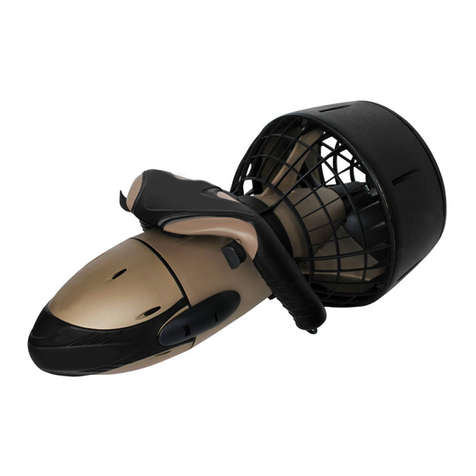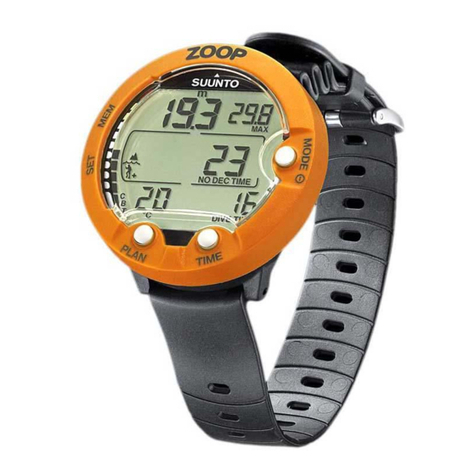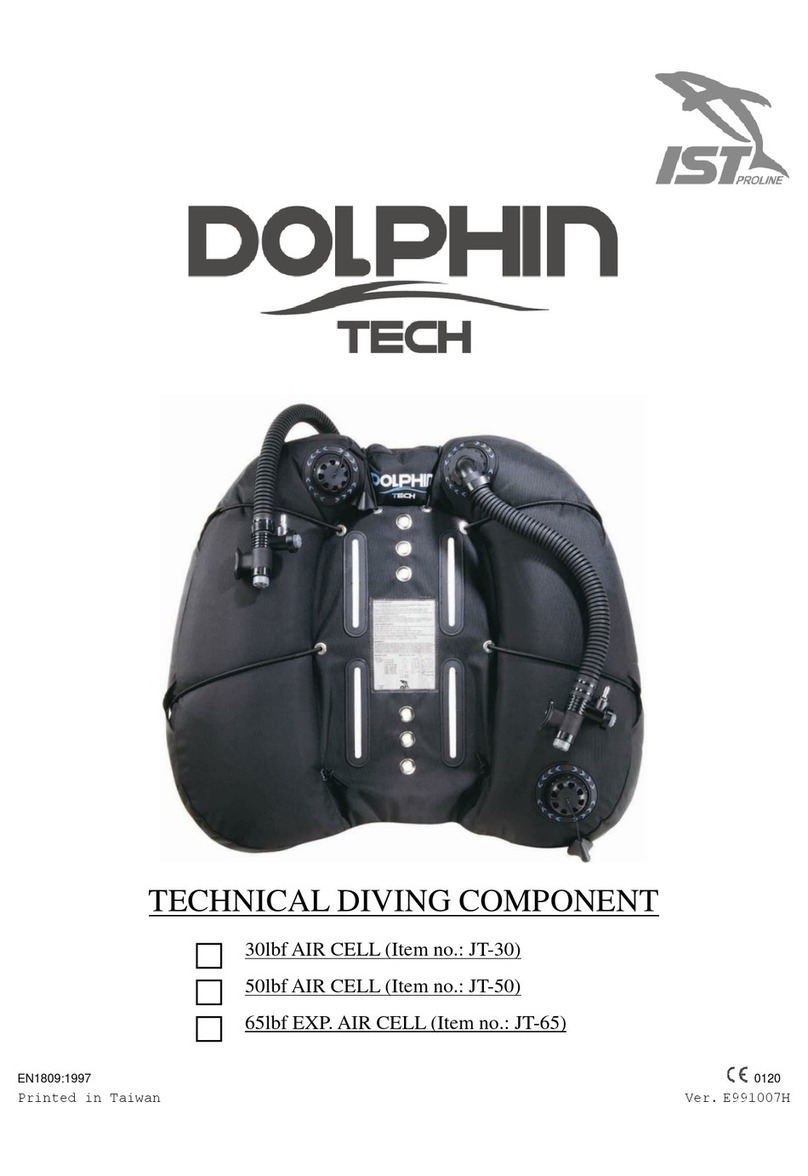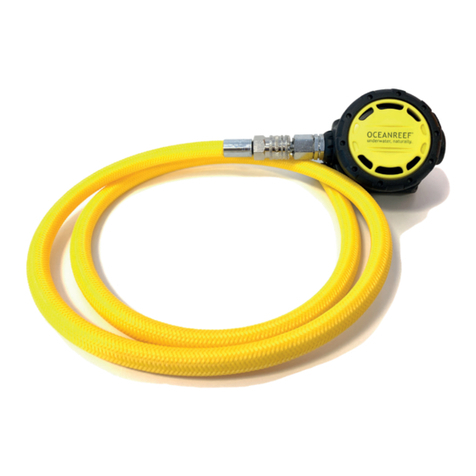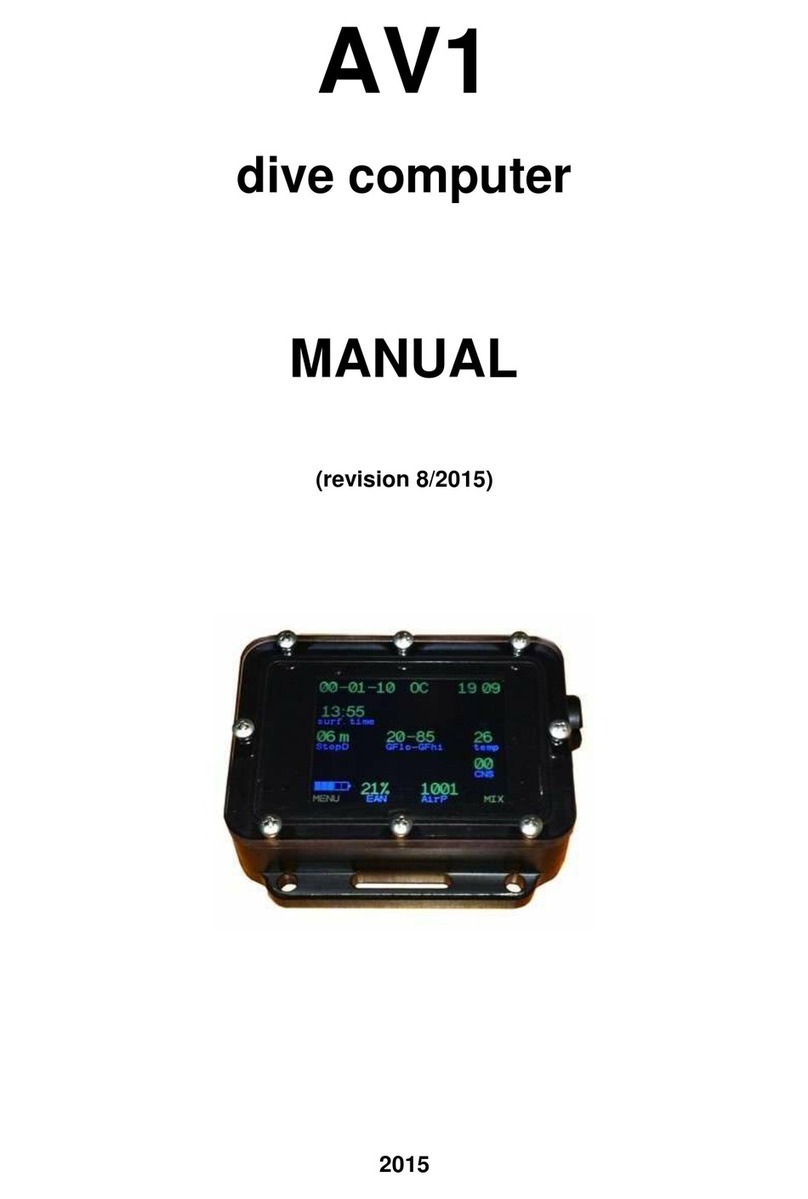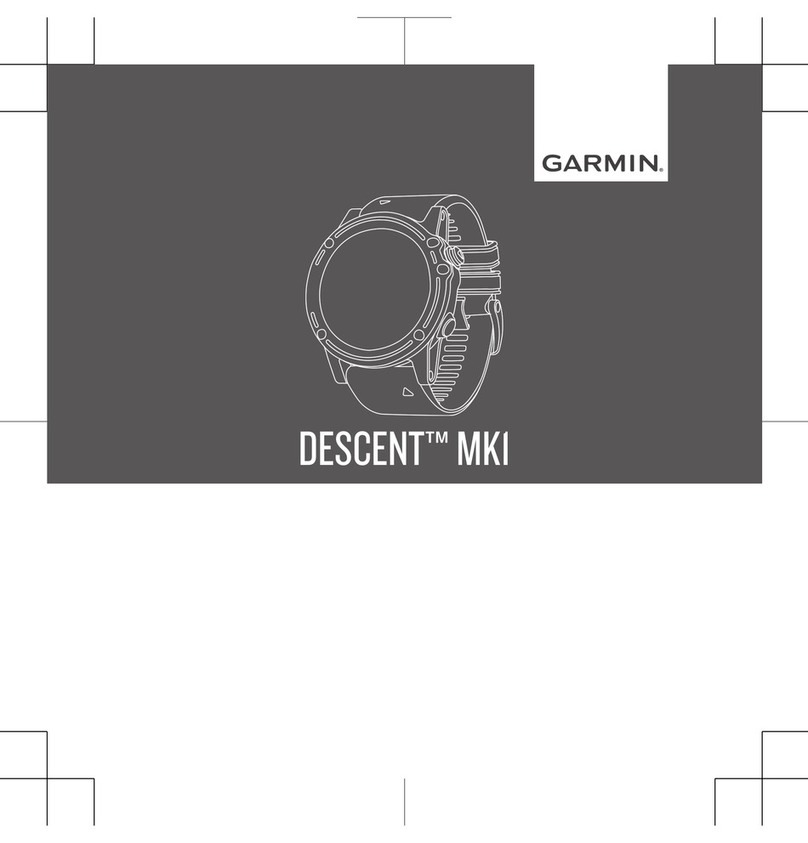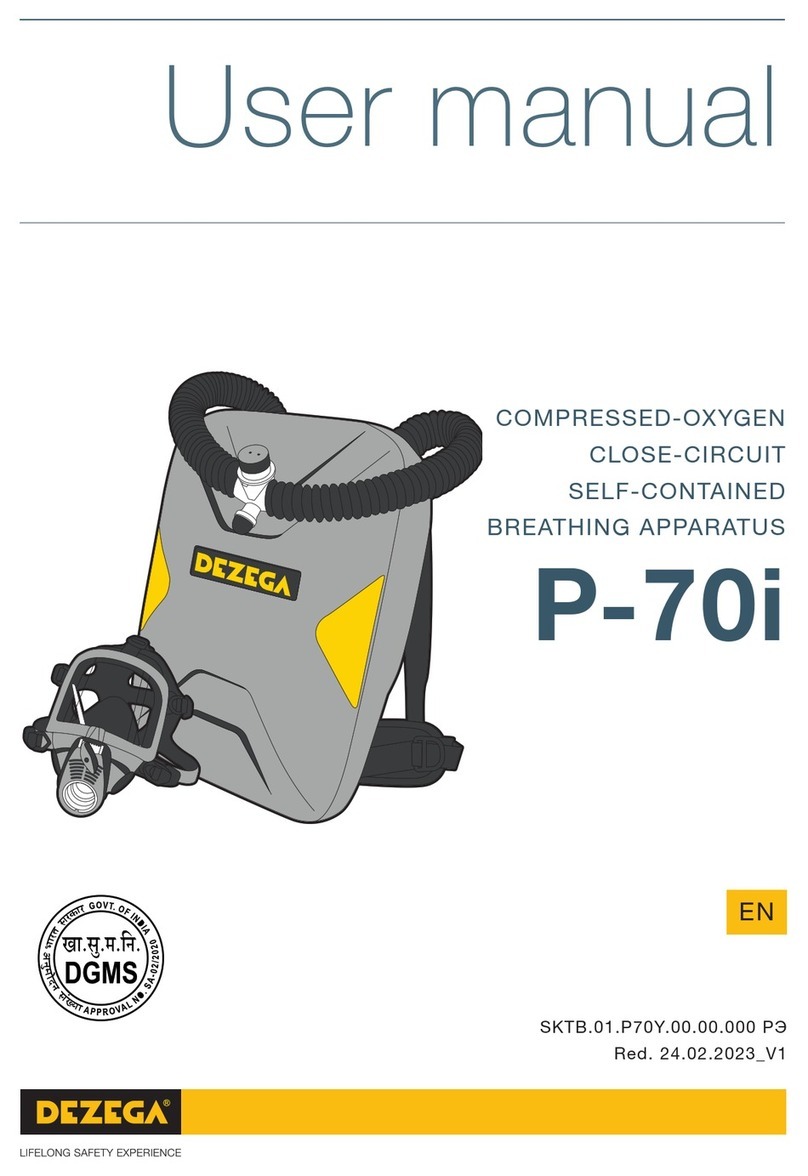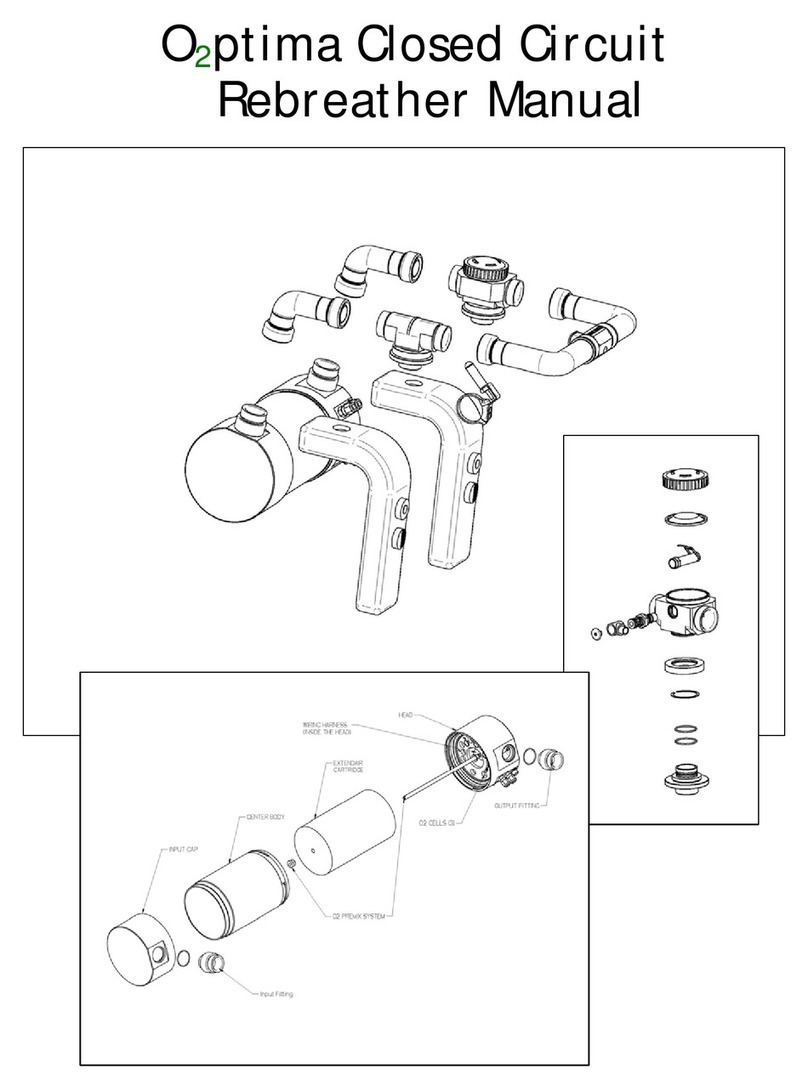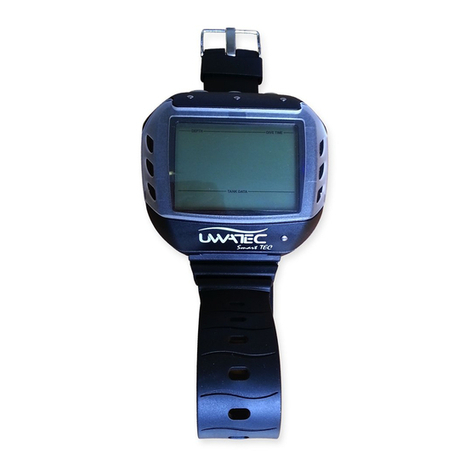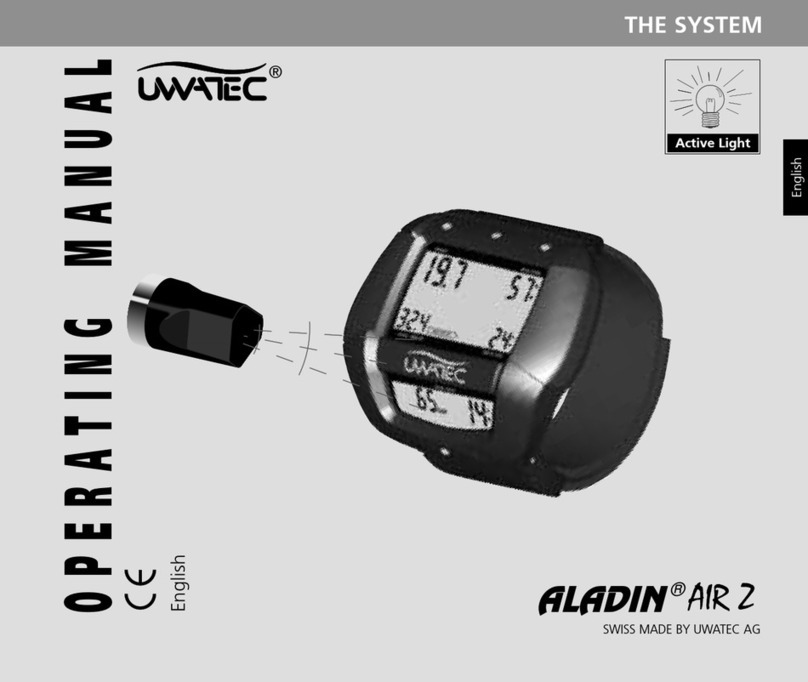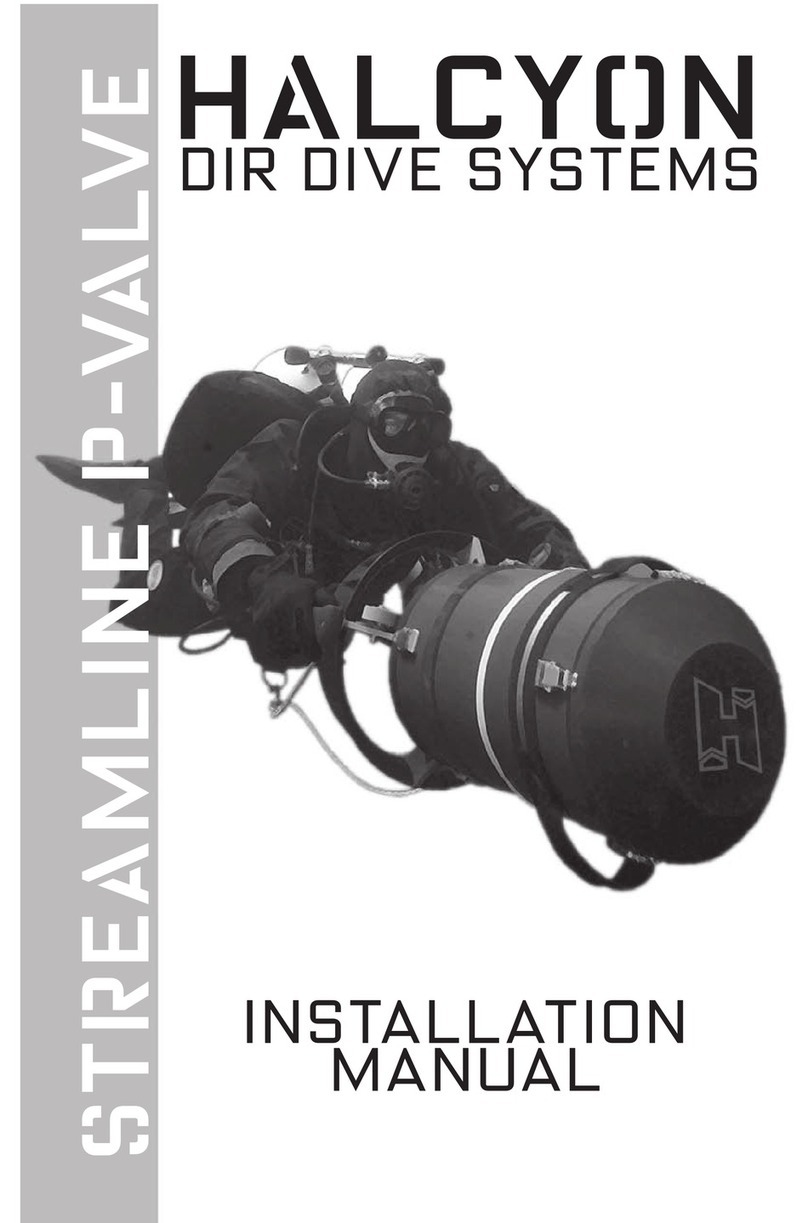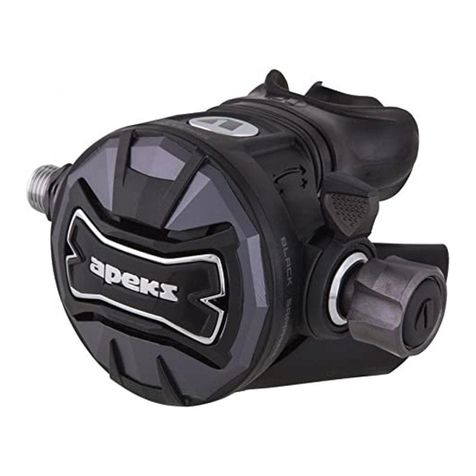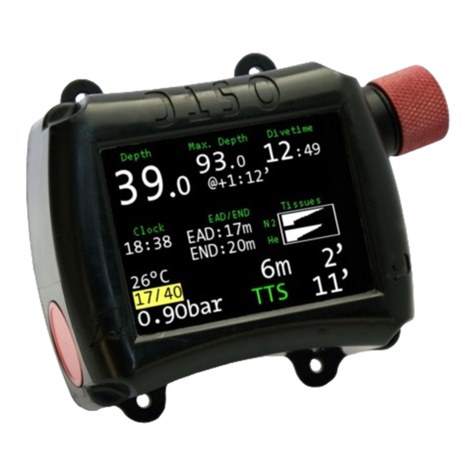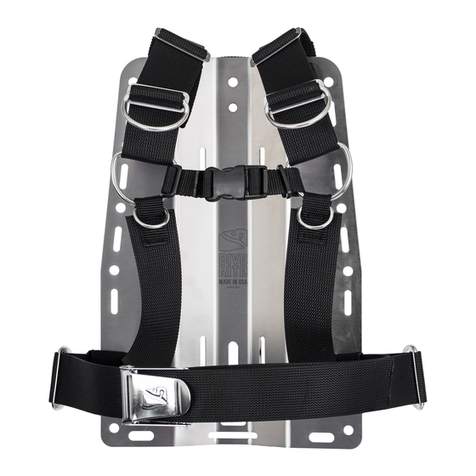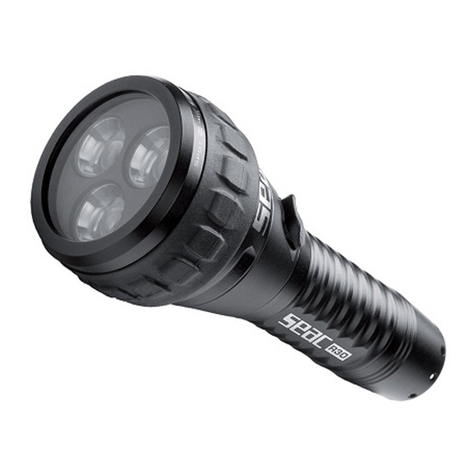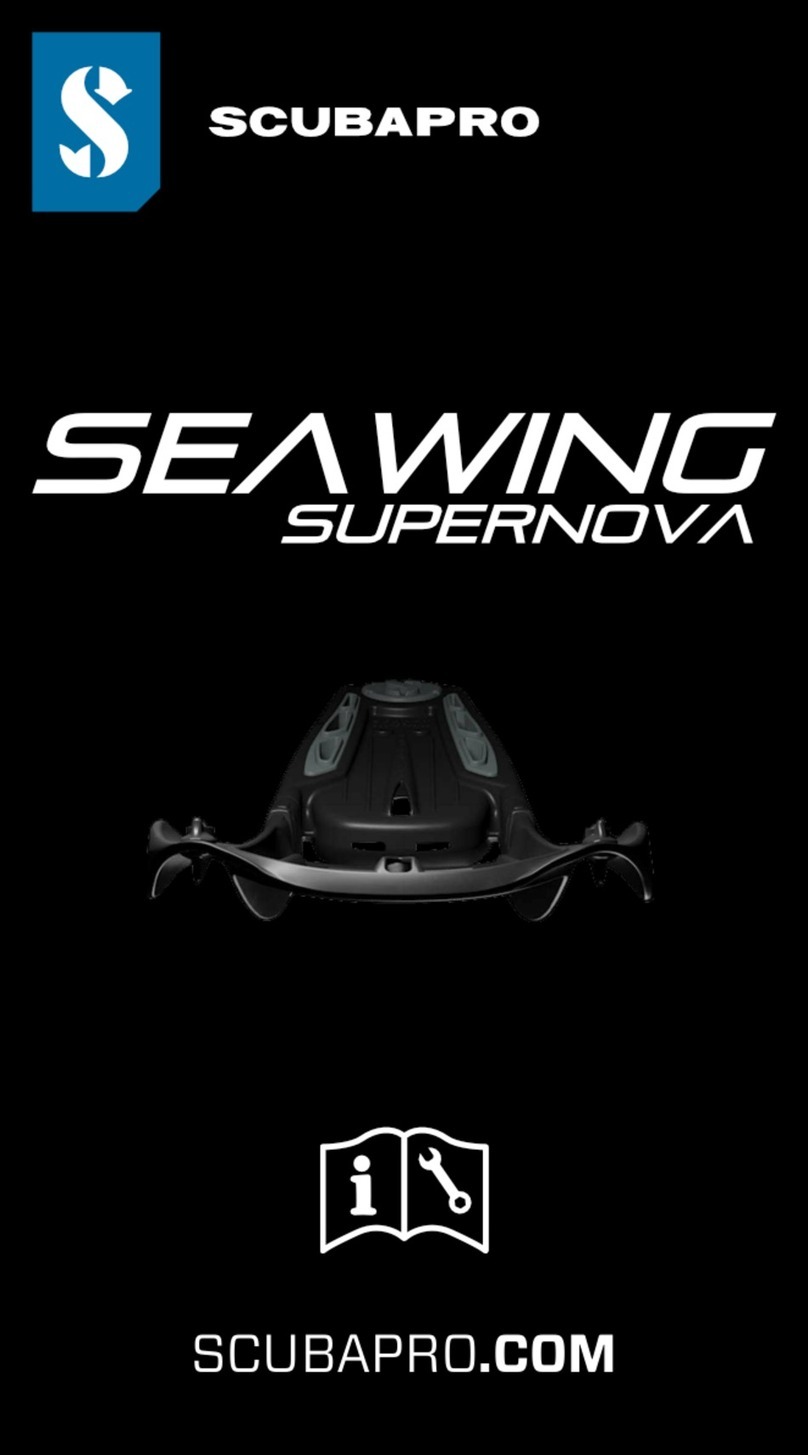SF TECH Neoprene Classic User manual

SF TECH DRYSUIT
User manual / Mode d’emploi / Benutzerhandbuch

2
ENGLISH
TABLE OF CONTENTS
1. INTRODUCTION 3
Manufacturer 3
Pictograms 3
Reference Standards 3
Serial Number 3
Temperature Range 3
Service Life 3
Warranty 3
2. DISCLAIMER 4
Warnings 4
Usage limitations 4
3. DRYSUIT SPECIFICATIONS 5
Neoprene 5
Trilaminate 5
Sizing 5
4. ZIPPER 7
Usage 7
Storage and maintenance 7
5. LATEX WRIST AND NECK SEALS 8
Usage 8
Trimming the seals 8
Storage and maintenance 8
Allergy 8
6. FITTING AND USAGE 9
Pre-dive 9
Donning 9
Dong 11
Foldingthesuit 11
Usageduringdive 12
Changeofbuoyancyandlossofthermalinsulationatdepth 12
7. MAINTENANCE 12
Post-divecheck 12
Cleaning 12
StorageandTransport 12
InspectionIntervals 12
8. ACCESSORIES 13
Pockets 13
Drygloves 13
P-valve 13
Inationanddumpvalves 13
9. DISPOSAL 13

3
ENGLISH
1. INTRODUCTION
MANUFACTURER
SF Tech Sàrl
RteduVerney18
1070Puidoux
Switzerland
Phone:+41219462988
www.sftech.ch
PICTOGRAMS
Warning
Read the manual
Do not wash
Do not iron
Do not tumble dry
Do not dry clean
REFERENCE STANDARDS
PN-EN14225-2:2005
SERIAL NUMBER
Number in the serie
Year
Trimester
Type of drysuit
(C=Classic Neo, K=Kevlar Neo,
T=TrilamTNT=Titanium Neoprene Trilaminate)
TEMPERATURE RANGE
SF Tech drysuits must be used with thermal undergarments adapted to climatic conditions.
SERVICE LIFE
Theservicelifevariesaccordingtothenumber,typeanddurationofdivesandislimitedto10years.
After this period, the drysuit must be checked annually by an authorized service center. Its lifespan
canbeextendedfromyeartoyear.
WARRANTY
The purchase of a SF Tech drysuit gives access to a free annual control.
SFTechoersalifetimewarrantyonseamsandworkmanship,andthefollowingdurations:
Neoprene or Trilaminate fabrics: 5 years.
Latexwristandneckseals:6months
Zipper:1year
Boots:1year
The warranty does not cover damage resulting from improper use.
C 02 16 45

4
ENGLISH
2. DISCLAIMER
WARNINGS
Read this entire manual carefully before using the drysuit. Keep it for future reference.
This manual should not be used as a substitute for drysuit training.
Thisdivingdrysuitisintendedforusebyacertieddiverwhohassuccessfullycompleteda
courseintheuseofdrysuitorbyadiverintrainingunderthesupervisionofaqualiedinstructor.
Diving in an environment which is chemically, biologically, or radiologically contaminated is
extremelyhazardous.SFTechDrysuitsshouldnotbeusedinsuchenvironments.
Perform regular preventative maintenance on the suit, valves, zipper and seals.
Inspect the valves, zipper, seals and seams for damage before each dive.
Do not use this drysuit as a main buoyancy device. Always dive with a buoyancy compensator.
This drysuit should always be used with undergarment adapted to the environmental conditions.
Failure to do so could result in thermal hazards such as hypothermia or hyperthermia.
Thermal insulation and buoyancy of the drysuit and undergarments may change at depth.
Always dive with a suit adapted to your size.
Fabric, compounds and additives of the suits might cause allergic reactions to some people.
Failure to follow all warnings and instructions in the manual may result in serious injury or death.
USAGE LIMITATIONS
Use this drysuit only if certied by a recognized training organization or under the direct
supervisionofaqualiedinstructor.
Themaximumoperatingdepthisdeterminedbythediver’strainingandqualications.
Onlyusenormalairtoinatethedrysuit.Anyothergasessuchasoxygenenrichedair(Nitrox),
argonorheliumenrichedgases(Trimix)couldcausehealthinjuriesordamagetheequipment.

5
ENGLISH
3. DRYSUIT SPECIFICATIONS
NEOPRENE
Neoprene used for drysuit is a closed-cell neoprene foam made of synthetic rubber containing
small enclosed bubbles of nitrogen gas. Nitrogen having a low thermal conductivity, it minimizes
heat transport through the material. Therefore, neoprene material has its inherent thermal protection
and buoyancy. The hyper-compressed neoprene used on SF Tech drysuits is very dense and resists
compression at depth. The suit only loses a small percentage of its surface buoyancy and thermal
insulation when the ambient pressure increases. Overall, a neoprene suit requires less added
insulation under the suit than a trilaminate drysuit.
Our neoprene suits are made of 2mm hyper compressed neoprene, laminated with nylon and
polyesterjersey.Theexteriorlayerismadeofheavy-dutyweavereinforcedwithKevlar®fabricto
withstand wear and abrasion while the inside is designed for comfort. Every seams are sewn with a
two thread locking blind-stitch and the inside is sealed with 3-5 layers of urethane sealant.
TRILAMINATE
Trilaminate suits, also known as trilam or membrane suits, are made of a multi-layer material. This
kindofmaterialisnotasstretchyasneoprene,howeveritismoreexibleandprovidesagood
range of motion. Trilaminate has neither inherent thermal protection nor buoyancy. The suit provides
a waterproof shell and the thermal insulation is made by the undergarment.
Our trilaminate suits are made of a middle layer of waterproof butyl laminated between two layers
offabric.TheexteriorismadeofNylonRipstopandKevlar®fabrictowithstandwearandabrasion
while the inside is designed for comfort. The seams are sewn with triple stitch and the inside is
sealed with 3-5 layers of urethane sealant.
TNT: TITANIUM NEOPRENE TRILAMINATE
Revolutionary material invented and developed in the premises of SF Tech, TNT is a trilaminate
material using high density neoprene foam as an impermeable layer instead of butyl rubber
A layer of hyper-compressed neoprene foam is coated of solid Titanium alloy, called Ti-Alpha,
creatinganecientinsulatingbarrier.Thematerialisthenlaminatedwithaexternallayermadeof
Kevlar®reinforcedberstowithstandwearandabrasionwhiletheinsideisdesignedforcomfort
The overall fabric undergoes a second compression process in a hyperbaric chamber. This process
createathin,exibleanddenseneoprenetrilaminate.Byusingneopreneasawaterproofmedium
insteadofbutyl,exibilityetheatinsulationaresubstantiallyenhanced.
The suit is assembled with triple stitch seams and the inside is sealed with 3-5 layers of urethane
sealant.
SIZING
We believe that each individual is unique, therefore all SF Tech drysuits are made to measure.

6
ENGLISH
Standard
Option
Model Neoprene Classic Neoprene Pro TNT Classic TNT Pro
Weight 5.0kg 5.0kg 4.0kg 4.3 kg
Sizing Made to measure Made to measure Made to measure Made to measure
Waterproof
material
Yamamoto 2mm hyper
compressed neoprene
Yamamoto 2mm hyper
compressed neoprene
Butyl Trilaminate Patented SF Tech TNT
material
Outer Fabric Kevlar®,Polyester,
Nylon,Spandex
Kevlar®,Nylon,Spandex Kevlar®,Nylon Kevlar®,Nylon
Inner Fabric Nylon Nylon Nylon, Polyester Nylon
Kevlar® Upper body, arms,
knees, crotch
Buttcocks
Full body Upper body, arms,
knees, crotch
Buttcocks
Full body
Colors Black
Red
Black
Red
Black
Red
Black
Red
Zipper YKKProseal®Metal
Protective zipper
YKKProseal®Metal
Protective zipper
YKKProseal®Metal
Protective zipper
YKKProseal®Metal
Protective zipper
Inationvalve Apeks
Si Tech
Apeks
Si Tech
Apeks
Si Tech
Apeks
Si Tech
Exhaustvalve ApeksHighProle
Apeks Low Prole
Si Tech
ApeksHighProle
Apeks Low Prole
Si Tech
ApeksHighProle
Apeks Low Prole
Si Tech
ApeksHighProle
Apeks Low Prole
Si Tech
Pockets 1 Pocket
2 Pockets
1 Pocket
2 Pockets
1 Pocket
2 Pockets
1 Pocket
2 Pockets
Neck seal Latex
Neoprene
Si Tech Silicone
Latex
Neoprene
Si Tech Silicone
Latex
Neoprene
Si Tech Silicone
Latex
Neoprene
Si Tech Silicone
Wrist seal Latex
Si Tech Silicone
Latex
Si Tech Silicone
Latex
Si Tech Silicone
Latex
Si Tech Silicone
Boots Neoprene 5mm
Rockboots
Neoprene 5mm
Rockboots
Neoprene 5mm
Rockboots
Neoprene 5mm
Rockboots
Hood 6mmneoprene
- Separeted
- Attached
6mmneoprene
- Separeted
- Attached
6mmneoprene
- Separeted
- Attached
6mmneoprene
- Separeted
- Attached
P-valve SF Tech SF Tech SF Tech SF Tech
Inationhose Miex90cm Miex90cm Miex90cm Miex90cm
Drygloves Rolock
Si Tech
Rolock
Si Tech
Rolock
Si Tech
Rolock
Si Tech

7
ENGLISH
4. ZIPPER
SFTechdrysuitareequippedwithametalYKKProseal®Zipper.Thewaterproofzipperprovidesa
watertight fastener for the drysuit. It is a fragile yet essential part of the suit and should be treated
with the utmost care. The larger teeth visible on the outside of the zipper are clamps that secure
the smaller teeth, visible on the inside surface of the zipper. It is these smaller teeth that interlock
andcreatermevenpressureonthepolymerzippertape,creatingtheseal.Theouterteethmust
be lubricated and the overall fastener must be clean and free of dirt. Proper maintenance of the
fastener will ensure a good seal and a long service life.
USAGE
Takingcareofthe zipper is asimplebut necessary tasktoperform. Apply paran aslubricant
beforeeachdive.Applyparanwhenthezipperisopen,andonlyontheoutsideteeth.NEVER use
silicone-based lubricant. Before operating the zipper, ensure it is clean and free of any objects
(sand, mud, etc.) that may result in poor tightness or damage the zipper.
When donning or dong the drysuit, the zipper MUST BE COMPLETELY OPEN.
Donningordong asuitwithazipper partiallyopenwilldamagethesidetapeand
the zipper will break. When opening or closing, always ensure that the pulling direction
is along the line of the metal teeth and that both sides of the zipper are parallel. It is
very important to avoid catching undergarments in the teeth. If the slider should jam when closing,
DO NOT FORCE IT. Pull back the slider, remove the obstruction and slowly attempt to close it
again.Excessiveforcewillbreakthemetalchainanddestroythefastener.Avoidbendingthezipper
excessivelyasthiswilleventuallycausethemetalchaintobreak
STORAGE AND MAINTENANCE
After using the zipper, it should be rinsed with clean fresh water. Any objects (sand, mud, etc.) found
in or outside of the teeth before operating the zipper may result in poor tightness or may damage
the zipper. When the zipper tape starts to fray, carefully burn the strings to avoid them being caught
in the zipper.
Store the zipper in a cool dry place and avoid direct sunlight. Store the zipper COMPLETELY
OPEN, taking care not to bend it. Storage of the zipper in a closed position for a long period will
cause malformation of the sealing areas. Also, storing partially opened will cause zipper bending. If
theseeectsoccur,slightleaksmayresult.Donotplaceanyheavyobjectonthezipper.
Do not dry clean, machine wash or iron.

8
ENGLISH
5. LATEX WRIST AND NECK SEALS
AllSFTechDrysuitscomestandardwithlatexwristandnecksealsforwatertightintegrity.
USAGE
Alwaysusecautionwhenpullingonthewristandneckseal.Donotuseexcessiveforceandavoid
contactwithsharp objects,like ringsandngernails,as itmight damagetheseals.Tofacilitate
donninganddong,dusttheinsideofthesealswithunperfumed talcum powder. Do not put too
muchtalcastheexcesswillgointhedrysuitandmightclogupthedumpvalveovertime.
TRIMMING THE SEALS
Toprovideacomfortableyetwatertightseal,itmightbenecessarytotrimthelatexseals.Thelatex
sealsaretaperedandhavemultipletrimlinesovertheend.Carefullycutoonesectionatatime
withasharpscissorstoachieveasnugt.Alwaysusesharpscissorsandcutthesealassmooth
as possible. Do not cut across the trim lines and avoid any sharp edges.
Perfect Acceptable To Avoid
STORAGE AND MAINTENANCE
Rinse the seals with clean fresh water after every dive. Accumulated body oils will shorten the
lifetimeofthelatexseals.Storethesuitinacooldryplaceandavoiddirectsunlight.Ultra-violet
lightwill degrade thelatex over time.Avoidanycontact between thelatex seals andanyother
syntheticmaterialforalongperiodoftime(f.ex.plastichanger).Ifthesealshavebeenexposed
tocoldtemperature,theywillbecomestiandloseexibility.Thisconditionisnotpermanentand
canberesolvebyabriefimmersioninwarmwater.Itisrecommendedtodustthelatexsealswith
unperfumed talcum powder before storing the suit for any length of time. Do not use any oil-
based product on the seals.
ALLERGY
A small percentage of the population have an allergic reaction to the proteins present in natural
rubberlatex.Theallergygenerallydevelopsafterrepeatedexposuretoproductscontainingnatural
rubberlatex,suchasthewristandneckseals.Thisallergycanrangefrommildskinrashtosevere
life-threatening reaction. It is the user responsibility to determine any allergic reaction to latex,
beforeorduringthedive,andtodiscontinueusingadrysuitwithlatexseals.Incaseofanyallergic
reaction, the drysuit manufacturer can provide alternative materials such as silicone or neoprene.

9
ENGLISH
6. FITTING AND USAGE
PRE-DIVE
Before each dive, make sure the suit is in good working condition.
Check the overall condition of the suit, looking for tear, hitch or hole.
Inspect the seams, making sure none of the threads are broken.
Control the wrist and neck seals. If a seal is cracked, sticky or worn, replace it before diving.
Make sure the inator, dump valve and P-valve are tighten and function properly. Follow the
manufacturer recommendation.
Inspectandcleanthezipper.Applysomeparanontheexteriorteethofthezipper.
Ifnecessary,dustthelatexwristandnecksealwithunperfumedtalcumpowder.
DONNING
Remove all jewelry, watch and necklace as it could tear the seals or damage the suit.
Put the undergarment suitable to the environmental conditions and the type of diving activity.
Ensure the protective zipper and waterproof zipper are COMPLETELY OPEN.Donningordong
a suit with a zipper partially open will damage the side tape and the zipper will break.
Grab the crotch of the suit and fold the upper part of the suit inside out over the legs to about
waist level.
Make sure the suspenders are outside of the legs, correctly attached and not entangled. The
crossover of the suspenders should be in the back of the drysuit.
Step into the suit with one leg, grasp the suit material at calf level and gently ease the foot into
the boot. Pull the suit up your thigh.
Repeat with the other leg.
Grasp the waist of the suit and gently pull it up so that the crotch of the suit is correctly positioned
betweenthelegs.Becarefulnottoputexcessiveforceonthezipperend.
Put the suspenders over the shoulders and adjust the length.
Optional: Connect the P-valve.
Once properly positioned from the chest down, pull the upper part of the suit all the way up to the
chest.

10
ENGLISH
Starting with the left armrst,grabthewristoftheundergarmentandslipthearmintothesleeve.
Let go the undergarment when reaching the wrist seal. Gently push your hand through the wrist
seal. Make sure the undergarments are not caught between the seal and the wrist or it will leak.
Pull the shoulder of the suit all the way to the neck.
Repeat with the right arm.
Toputtheneckseal,insertbothhandsintheheadopening,ngerin,thumbsout,andgrabthe
collar of the suit. Spread the neck seal wide open, bend your head forward and pull the drysuit
overyourhead.Becarefulnottouseyourngernailsagainstthelatexorsmoothskinneoprene
as it may damage it. For a neoprene neck seal, fold it around 4cm toward the inside to have the
smooth surface against the skin.
Optional: Connect the heating system
To close the zipper, grab both side of the zipper at chest level, lift them up, pull forward then down
in order to move the top rubber stop of the zipper closer to the chest.
Grab the slider loop and pull it down in a direction parallel to the zipper chain. Only minimal
amount of force should be required to close the waterproof zipper. Make sure to not catch any
fabric or foreign object in the zipper as it may damage the teeth.
Fold the telescopic torso to avoid any fold on the zipper.
Adjust and clip the crotch strap.
Closethesliderofthezipperushagainsttherubberstop.
If the drysuit has a protective zipper, close it the same way.

11
ENGLISH
Attachalowpressurehosetotheinationvalveandmakesurethevalveisworkingproperly.
Tochecktheexhaustvalve,turnitopen,crouchtoyourkneesandcheckiftheairescapesfrom
the valve.
Put on the hood over your head. The neck of the hood can be tucked under the neoprene collar
of the suit for a better insulation.
DOFFING
Takeothedrysuitfollowingthesameprocedureasdonning,butinreverseorder.
Make sure the waterproof zipper is COMPLETELY OPEN before removing the suit.
FOLDING THE SUIT
Ensure the protective zipper and waterproof zipper are COMPLETELY OPEN.
Laythedrysuitfacedownonacleanandatsurface,armswideopen.
Fold the suit in half at crotch level
Foldthelegsin2(or3,dependingonthesizeofthesuit)makingsurethebootsandpocketsdon’t
create any bad fold on the suit material.
Foldthetopofthesuitontopofthelegs,makingsurethezippermakeanicecurveanddoesn’t
have any sharp bend.
Cross the arms on the chest.
Put the folded drysuit into the bag.

12
ENGLISH
USAGE DURING DIVE
This diving drysuit is intended for use by a certied diver who has successfully
completed a course in the use of drysuits or by a diver in training under the supervision
ofaqualiedinstructor.
Beforethedive,ventexcessairfromthedrysuitbypressingthedumpvalveandcrouchingdown
toyourknees.Jumpinginthewaterwithexcessairinthesuitmaybehazardousandshouldbe
avoided.EnterthewaterwithyourBCDpartiallyinated.
During the dive, keep the amount of air in the drysuit to the minimum to feel warm and comfortable.
Do not use the drysuit as the main buoyancy device.
CHANGE OF BUOYANCY AND LOSS OF THERMAL INSULATION AT DEPTH
All neoprene products used in scuba diving are made of closed cell foam containing small bubble
of nitrogen to provide thermal insulation. When the pressure increases at depth, these bubbles
diminish in size and the material becomes thinner. This results in a loss of buoyancy and insulation
at depth.
Trilaminate material is a membrane without a closed cellular structure. The material provides minimal
thermal insulation and does not change buoyancy at depth.
Air trapped within the suit by the thermal undergarments provides both thermal insulation and
buoyancy. Variation of depth will result in a change of buoyancy and thermal insulation, therefore air
must be added or vented accordingly.
7. MAINTENANCE
POST-DIVE CHECK
After each dive, complete the pre-dive checks and thoroughly inspect the suit for any new possible
damage that may have appeared during the dive. If any repair has to be made, contact the
manufacturer, or take the suit to an authorized SF Tech dealer.
CLEANING
After each dive, thoroughly rinse the outside of the suit, the seals and the valves with clean fresh
water. Thoroughlyrinse bothsideof the zipperwithclean freshwater and brushoany object
attached. If the suit got wet inside, rinse it with clean fresh water and let the drysuit dry inside out.
STORAGE AND TRANSPORT
Proper storage will extend the life of your drysuit. Store the suit in a cool dry place and avoid
directsunlight,chemicals,openre,heatingdevicesorelectricalequipmentproducingozone.Itis
important to not store the drysuit folded or rolled as it may cause a deformation and damage the
integrity of the suit. Store the drysuit on a wide hanger with the zipper open. The drysuit can also be
hung upside-down by the feet, zipper open. Before storing the suit for any length of time, dust the
latexsealswithunperfumedtalcumpowderasapreservative
Transport the drysuit properly fold in its bag, zipper COMPLETELY OPEN, and do not place any
heavy object on top of it. Do not store the suits in its bag for a long period of time.

13
ENGLISH
INSPECTION INTERVALS
In addition to the pre- and post-dive checks, the suits and the valves should be inspected annually
by the manufacturer or an Authorized SF Tech dealer.
8. ACCESSORIES
AllSFTechdrysuitscomestandardwithahood,abaganda90cmlowpressureinatorhose.In
addition,thesuitcanbeequippedwithvariousoptionsasshowninthedrysuitspecications.
POCKETS
The SF Tech Pocket is the perfect accessory to store your diving
equipment while diving. Spare mask, surface marker, spool and
various other items. The main pocket has an internal volume of
2.5 liters and is equipped with a d-ring and 2 strings to attach your
equipment. On the top of the pocket, a compartment with a zipper
allows to store small material.
DRY GLOVES
Various brands and models of dry gloves can be mounted on all SF
Tech drysuits. SF Tech recommends the Rolock Dry Gloves System
for all latex and silicone seals. For any information about those
products,refertotheappropriateowner’smanual.
P-VALVE
All SF Tech drysuits can be equipped with a SF Tech Balanced
P-valve, either for a brand new suit or later as an option. The main
installation of the P-valve has to be made by the manufacturer,
however, the P-valve can be replaced by the user if necessary. The
valveismadeofaDelrinbodywitha60cmnorprenetubing.
INFLATION AND DUMP VALVES
AllSFTechdrysuitsarettedinstandardwithApeksinationand
dump valves. As an option, Si Tech valves can also be mounted.
For any information about those products, refer to the appropriate
owner’smanual.
9. DISPOSAL
At the end of its useful life, it is necessary to reprocess the suit and its accessories in accordance
with local regulations and prescriptions

14
FRANÇAIS
TABLE DES MATIÈRES
1. INTRODUCTION 15
Fabricant 15
Pictogrammes 15
Référence des standards 15
Numéro de série 15
Température d’utilisation 15
Durée de vie 15
Garantie 15
2. AVERTISSEMENT 16
Avertissement 16
Limites d'utilisation 16
3. CARACTÉRISTIQUES 17
Néoprène 17
Trilaminé 17
TNT: Titanium Neoprene Trilaminate 17
Dimensions 17
4. FERMETURE ÉCLAIR ÉTANCHE 19
Utilisation 19
Stockage et entretien 19
5. MANCHONS ET COLLERETTE EN LATEX 20
Utilisation 20
Ajustement 20
Stockage et entretien 20
Allergie 20
6. UTILISATION 21
Pré-plongée 21
Enlez la combinaison 21
Enlever la combinaison 23
Plier la combinaison 23
Utilisation durant la plongée 24
Changement de ottabilité et perte d'isolation thermique 24
7. ENTRETIEN 24
Contrôle après-plongée 24
Nettoyage 24
Stockage et transport 24
Inspection annuelle 25
8. ACCESSOIRES 25
Poches 25
Gants étanches 25
Purge urinaire 25
Purge et Inateur 25
9. RECYCLAGE 25

15
FRANÇAIS
1. INTRODUCTION
FABRICANT
SF Tech Sàrl
Rte du Verney 18
1070 Puidoux
Suisse
Tel: +41 21 946 29 88
www.sftech.ch
PICTOGRAMMES
Attention
Lire le mode d'emploi
Ne pas laver
Ne pas repasser
Pas de séchage en tambour
Pas de lavage à sec
RÉFÉRENCE DES STANDARDS
PN-EN 14225-2:2005
NUMÉRO DE SÉRIE
Numéro de la combinaison
Année
Trimestre
Type de combinaison
(C=Classic Neo, K=Kevlar Neo, T=Trilam,
TNT=Titanium Neoprene Trilaminate)
TEMPÉRATURE D’UTILISATION
Les combinaisons SF Tech doivent être utilisées avec une sous-combinaison adaptée aux conditions
climatiques.
DURÉE DE VIE
La durée de vie varie selon le nombre, le type et la durées des plongées et est limitée à 10 ans.
Passé ce délai, la combinaison devra être contrôlée annuellement par un centre de service agréé
par la marque. Sa durée d’utilisation pourra être prolongée d’année en année.
GARANTIE
L’achat d’une combinaison SF Tech donne accès à un contrôle général annuel gratuit à vie.
SF Tech ore une garantie à vie sur la fabrication et les coutures, et les durées suivantes:
Néoprène ou tissus trilaminés: 5 ans.
Manchons et collerettes latex: 6 mois
Fermeture éclair: 1 an
Bottillons: 1an
La garantie ne couvre pas les dégât qui résultent d’une utilisation inappropriée.
C 02 16 45

16
FRANÇAIS
2. AVERTISSEMENT
AVERTISSEMENT
Lisez ce manuel attentivement avant d'utiliser la combinaison étanche. Gardez-le pour de futures
références.
Ce manuel ne doit pas être utilisé comme substitut à un cours de plongée en combinaison
étanche.
Cette combinaison étanche est destinée à être utilisée par un plongeur certié ayant terminé
une formation de plongée en combinaison étanche ou par un plongeur en formation sous la
supervision directe d'un instructeur qualié.
Plonger dans un environnement qui est chimiquement, biologiquement ou radiologiquement
contaminé est extrêmement dangereux. Les combinaisons de plongée SF Tech ne doivent pas
être utilisées dans de tels environnements.
Eectuer un entretien préventif régulier sur la combinaison, la purge, l'inateur, la fermeture éclair
et les manchons.
Inspecter la purge, l'inateur, la fermeture éclair et les manchons avant chaque plongée.
Ne pas utiliser cette combinaison de plongée comme dispositif de ottabilité principal. Plongez
toujours avec un gilet stabilisateur.
Cette combinaison étanche doit toujours être utilisée avec des sous-vêtements adaptés aux
conditions environnementales. Le non-respect peut entraîner des risques tels que l'hypothermie
ou l'hyperthermie.
L'isolation thermique et la ottabilité de la combinaison étanche et des sous-vêtements peuvent
changer durant la plongée.
Toujours plonger avec une combinaison étanche adaptée à votre taille.
Les matériaux utilisés pour la fabrication des combinaisons peuvent provoquer des réactions
allergiques chez certaines personnes.
Le non-respect des consignes de sécurité peut entraîner des blessures graves voire mortelles.
LIMITES D'UTILISATION
Utiliser cette combinaison étanche que si certié par un organisme de formation reconnu ou sous
la supervision directe d'un instructeur qualié.
La profondeur maximale d’utilisation est déterminée par la formation et la qualication du
plongeur.
Utiliser uniquement de l'air comprimé pour goner la combinaison étanche. Tous les autres gaz,
tels que l'air enrichi en oxygène (Nitrox), l'argon ou des gaz enrichi en hélium (Trimix) pourraient
causer des dommages à la santé ou endommager l'équipement.

17
FRANÇAIS
3. CARACTÉRISTIQUES
NÉOPRÈNE
Le néoprène utilisé pour les combinaisons est une mousse de néoprène à cellules fermées en
caoutchouc synthétique contenant des bulles d'azote. L'azote ayant une faible conductivité
thermique, il réduit au minium les échanges thermiques à travers le matériau. Par conséquent, le
néoprène a une protection thermique et une ottabilité inhérentes. Le néoprène hyper-compressé
utilisé dans les combinaisons SF Tech est très dense et résiste à la compression en profondeur. La
combinaison ne perd qu'un faible pourcentage de sa ottabilité et de son isolation thermique de
surface lorsque la pression ambiante augmente. Dans l'ensemble, une combinaison en néoprène
nécessite moins d'isolants thermiques qu'une combinaison en trilaminé.
Nos combinaisons en néoprène sont faites d'un néoprène hyper-compressé de 2mm, laminé de
tissu en polyester et nylon. La couche externe est recouverte de tissu résistant renforcé de bres
de Kevlar® pour résister à l'usure et à l'abrasion, tandis que la couche interne est conçu pour le
confort. Toutes les coutures sont cousues avec une chaînette non-traversante à 2 ls et l'intérieur
est scellé par 3-5 couches de colle uréthane.
TRILAMINÉ
Les combinaisons étanches en trilaminé sont fabriquées en tissu composé de 3 couches (d'où
le nom trilaminé). Ce type de matériel n'est pas aussi élastique que du néoprène, mais il est plus
souple et ore une bonne amplitude de mouvement. Le trilaminé n'a ni protection thermique ni
ottabilité inhérente. La combinaison crée une enveloppe étanche et l'isolation thermique est faite
par les sous-vêtements.
Nos combinaisons en trilaminé sont constituées d'une couche médiane en caoutchouc de butyl
étanche laminée de deux couches de tissu. L'extérieur est en Nylon Ripstop et en Kevlar® pour
résister à l'usure et à l'abrasion tandis que l'intérieur est conçu pour le confort. Toutes les coutures
sont cousues avec point triple et l'intérieur est scellé avec 3-5 couches de colle uréthane.
TNT: TITANIUM NEOPRENE TRILAMINATE
Nouveau matériau révolutionnaire inventé et développé dans les locaux de SF Tech, TNT est un
matériau trilaminé utilisant une mousse de néoprène haute densité comme couche imperméable au
lieu du caoutchouc butyl.
Une couche de mousse de néoprène hyper-compressé est recouverte d’un revêtement en alliage
de Titane, appelé Ti-Alpha, créant ainsi une barrière isolante ecace. Le matériau est ensuite laminé
avec un tissu extérieur à base de bre de Kevlar® pour résister à l’usure et à l’abrasion tandis que
l’intérieur est conçu pour le confort.
L’ensemble du matériau subit une seconde phase de compression dans une chambre hyperbare.
Ce processus crée un trilaminé de néoprène très n, exible et ultra dense. En utilisant le
néoprène comme matériel imperméable au lieu du butyl, la exibilité et l’isolation thermique sont
considérablement améliorées.
La combinaison est assemblée avec des coutures à point triple et l’intérieur est scellé avec 3-5
couches de colle uréthane.
DIMENSIONS
Nous sommes persuadés que chaque individu est unique. Pour cette raison, toutes les combinaisons
étanches SF Tech sont fabriquées sur mesure.

18
FRANÇAIS
De série
En option
Modèle Neoprene Classic Neoprene Pro TNT Classic TNT Pro
Poids 5.0 kg 5.0 kg 4.0 kg 4.3 kg
Taille Sur mesure Sur mesure Sur mesure Sur mesure
Matériel Néoprène 2mm hyper-
compressé
Néoprène 2mm hyper-
compressé
Trilaminé de butyl Matériau SF Tech TNT
breveté
Tissu externe Kevlar®, Polyester,
Nylon, Spandex
Kevlar®, Nylon, Spandex Kevlar®, Nylon Kevlar®, Nylon
Tissu interne Nylon Nylon Nylon, Polyester Nylon
Kevlar® Torse, bras, genoux,
entrejambe
Fessiers
Corps complet Torse, bras, genoux,
entrejambe
Fessiers
Corps complet
Couleurs Noir
Rouge
Noir
Rouge
Noir
Rouge
Noir
Rouge
Fermeture
étanche
YKK Proseal® Metal
Sur-fermeture de
protection
YKK Proseal® Metal
Sur-fermeture de
protection
YKK Proseal® Metal
Sur-fermeture de
protection
YKK Proseal® Metal
Sur-fermeture de
protection
Inateur Apeks
Si Tech
Apeks
Si Tech
Apeks
Si Tech
Apeks
Si Tech
Purge Apeks High Prole
Apeks Low Prole
Si Tech
Apeks High Prole
Apeks Low Prole
Si Tech
Apeks High Prole
Apeks Low Prole
Si Tech
Apeks High Prole
Apeks Low Prole
Si Tech
Poches 1 Poche
2 Poches
1 Poche
2 Poches
1 Poche
2 Poches
1 Poche
2 Poches
Collerette Latex
Néoprène
Si Tech Silicone
Latex
Néoprène
Si Tech Silicone
Latex
Néoprène
Si Tech Silicone
Latex
Néoprène
Si Tech Silicone
Manchons Latex
Si Tech Silicone
Latex
Si Tech Silicone
Latex
Si Tech Silicone
Latex
Si Tech Silicone
Chaussures Néoprène 5mm
Rockboots
Néoprène 5mm
Rockboots
Néoprène 5mm
Rockboots
Néoprène 5mm
Rockboots
Cagoule Néoprène 6mm
- Amovible
- Attenante
Néoprène 6mm
- Amovible
- Attenante
Néoprène 6mm
- Amovible
- Attenante
Néoprène 6mm
- Amovible
- Attenante
P-valve SF Tech
Si Tech Trigon
SF Tech
Si Tech Trigon
SF Tech
Si Tech Trigon
SF Tech
Si Tech Trigon
Tuyau Miex 90cm Miex 90cm Miex 90cm Miex 90cm
Gants étanches Rolock
Si Tech
Rolock
Si Tech
Rolock
Si Tech
Rolock
Si Tech

19
FRANÇAIS
4. FERMETURE ÉCLAIR ÉTANCHE
Les combinaisons étanches SF Tech sont équipées de fermetures étanches YKK Proseal® en
métal. La fermeture éclair est une partie fragile mais indispensable de la combinaison étanche et
doit être traitée avec le plus grand soin. Les dents visibles à l'extérieur de la fermeture servent à
guider le curseur et la xation se fait par les petites dents visibles sur la face interne de la fermeture.
Ces petites dents se verrouillent entre elles et créent une pression ferme et régulière sur la bande en
polymère, assurant ainsi l'étanchéité. Les dents externes doivent êtres lubriées et l'ensemble de la
fermeture doit être maintenu propre et exempt de saleté. Un bon entretien de la fermeture garantira
une bonne étanchéité et une longue durée de vie.
UTILISATION
Prendre soin de la fermeture éclair est une tâche simple mais nécessaire. Appliquer de la parane
comme lubriant avant chaque plongée. Appliquer la parane lorsque la fermeture est ouverte et
uniquement sur les dents extérieures. NE JAMAIS utiliser de lubriant à base de silicone. Avant
d'utiliser la fermeture éclair, s'assurer qu'elle soit propre et exempt de tout objet (sable, boue, etc.)
pouvant entraîner une mauvaise étanchéité ou endommager la fermeture.
En mettant ou ôtant la combinaison étanche, la fermeture éclair DOIT ÊTRE COMPLÈTEMENT
OUVERTE. Enler une combinaison avec une fermeture partiellement fermée va endommager la
bande latérale et la fermeture s’abîmera prématurément. Lors de l'ouverture ou de la fermeture,
veiller à ce que la direction de traction se trouve le long de la ligne des dents en métal et que les deux
côtés de la fermeture soient parallèles. Il est important d'éviter d'attraper les sous-vêtements dans
les dents. Si le curseur devait se bloquer lors de la fermeture, NE PAS FORCER. Tirer le curseur
dans le sens opposé, enlever l'objet obstruant, et tenter de refermer la fermeture doucement. Plier
ou tirer sur la fermeture avec une force excessive brisera la chaîne de dents en métal et détruira la
xation.
STOCKAGE ET ENTRETIEN
Après utilisation, rincer avec de l'eau douce propre. Tous les objets (sable, boue, etc.) présents
dans, ou à l'extérieur, de la fermeture éclair peuvent entraîner une mauvaise étanchéité ou peuvent
endommager la fermeture étanche. Lorsque la bande de fermeture commence à s'elocher, brûler
soigneusement les ls pour éviter qu'ils se prennent dans la fermeture.
Ranger dans un endroit frais et sec, à l'abri de la lumière directe du soleil. Rangez la fermeture
COMPLÈTEMENT OUVERTE, en prenant soin de ne pas la plier. Si la fermeture est stockée fermée
pendant une période prolongée, une malformation des zones d'étanchéité peut se produire. En
outre, le stockage partiellement ouvert causera un pli sur la xation. Si ces eets se produisent, de
légères fuites sont possibles. Ne pas placer d'objets lourds sur la fermeture éclair.
Ne pas nettoyer à sec, laver en machine ou repasser.

20
FRANÇAIS
5. MANCHONS ET COLLERETTE EN LATEX
Toutes les combinaisons étanches SF Tech sont livrées de base avec des manchons de poignet et
une collerette en latex.
UTILISATION
Soyez toujours prudent lorsque vous tirez sur les manchons et la collerette. Ne pas utiliser une force
excessive et éviter tout contact avec des objets pointus, comme les bagues et les ongles, car cela
pourrait endommager le latex. Pour faciliter l'utilisation, saupoudrer l'intérieur des manchons avec
du talc non parfumé. Ne pas mettre trop de talc car l'excédent ira dans la combinaison étanche et
peut endommager la purge.
AJUSTEMENT
Pour assurer une utilisation confortable et étanche, il peut être nécessaire de couper les joints en
latex. Les manchons et la collerette sont coniques et ont plusieurs lignes de découpe à l'extrémité.
A l'aide d'une paire de ciseaux aûtés, couper avec précaution, une section à la fois, an d'ajuster
les manchons ou la collerette. Couper le latex le plus lisse possible, le long des marques et éviter
tout accrocs.
Parfait Acceptable Éviter
STOCKAGE ET ENTRETIEN
Rincer le latex avec de l'eau douce propre après chaque utilisation. Les huiles corporelles
accumulées réduisent la durée de vie du latex. Rangez dans un endroit frais et sec, à l'abri de
la lumière directe du soleil. Les rayons ultraviolets peuvent rapidement endommager le latex.
Éviter tout contact entre le latex et tout autre matériau synthétique pour une longue période (p.ex.
cintre en plastique). Si le latex a été exposé au froid, il peut devenir dur et perdre de sa souplesse.
Cette situation n'est pas permanente et peut être résolue par une brève immersion dans de l'eau
tempérée. Il est recommandé de saupoudrer le latex avec du talc non parfumé avant de stocker la
combinaison. Ne pas utiliser de produit à base d'huile sur le latex.
ALLERGIE
Un faible pourcentage de la population peut avoir une réaction allergique aux protéines présentes
dans le latex de caoutchouc naturel. L'allergie se développe généralement après une exposition
répétée à des produits contenant du latex de caoutchouc naturel, tels que les manchons et la
collerette. Cette allergie peut aller d'une légère éruption cutanée à une réaction grave voire mortelle.
Il est de la responsabilité de l'utilisateur de déterminer une quelconque réaction allergique au
latex, avant ou pendant la plongée, et de cesser d'utiliser une combinaison avec des manchons
ou collerettes en latex. En cas de réaction allergique, SF Tech peut fournir des matériaux de
remplacement tels que le silicone ou le néoprène.
This manual suits for next models
3
Table of contents
Languages:
